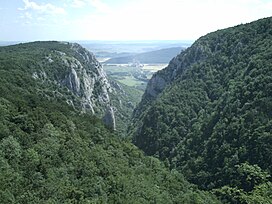The Slovak Ore Mountains (Slovak: Slovenské rudohorie [ˈslɔʋenskeː ˈrudɔɦɔrɪe], Hungarian: Gömör–Szepesi-érchegység, German: Slowakisches Erzgebirge or Zips-Gemer-Erzgebirge) are an extensive mountain range within the Carpathian Mountains, located mostly in Slovakia's Spiš and Gemer region, with a small part in northern Hungary.[1] It is the largest mountain range in Slovakia. Geomorphologically, the Slovak Ore Mountains belong to the Inner Western Carpathians.
| Slovak Ore Mountains | |
|---|---|
 Zadiel canyon in the Slovak Karst | |
| Highest point | |
| Peak | Stolica |
| Elevation | 1,476 m (4,843 ft) |
| Geography | |
| Range coordinates | 48°45′00″N 20°15′00″E / 48.75000°N 20.25000°E |
| Parent range | Inner Western Carpathians |

The mountains are bordered by Zvolen in the west, Košice in the east, the rivers Hron and Hornád in the north, and the Juhoslovenská kotlina and Košice Basin (Košická kotlina) in the south. The region includes the Domica Cave (jaskyňa Domica), one of the largest caves in Europe, Zádiel canyon and Krásna Hôrka Castle.
Subdivision
editGeomorphologically, the Slovak Ore Mountains are grouped within the Inner Western Carpathians. The mountains do not have a central ridge - they consist of several independent sections, geomorphological regions:[2]
- Vepor Mountains (Veporské vrchy)
- Spiš-Gemer Karst (Spišsko-gemerský kras)
- Stolica Mountains (Stolické vrchy)
- Revúca Highlands (Revúcka vrchovina)
- Volovec Mountains (Volovské vrchy)
- Black Mountain (Čierna hora)
- Rožňava Basin (Rožňavská kotlina)
- Slovak Karst (Slovenský kras) and Aggtelek Karst (Hungarian: Aggteleki-karszt; lies in northern Hungary)
Characteristics
editBasic data:
- highest peak: Stolica, 1,476 m AMSL
- length: c.140 kilometres (87 mi)
- width: c.40 kilometres (25 mi)
- area: c.4,000 square kilometres (1,500 sq mi)
Since this is a very extensive geomorphological unit, no general characterization is appropriate. The geomorphological structure is varied and has crystalline, Mesozoic and volcanic rocks.
The mountains were, as the name suggests, heavily mined but activity died out during the 19th century. There is evidence of copper mining since at least the Early Bronze Age.[3] which grew in importance during the early modern period. Deposits included ores of copper, lead, silver, gold, zinc and some iron. From 1494 one of the first multinational corporations was set up by the Thurzó and Fugger families to take advantage of the region's valuable economic resources.[3]
The towns of Banská Bystrica, Špania Dolina and Ľubietová were important centers of mining: in 1692, the first modern blast furnace in the Kingdom of Hungary was built in Ľubietová.
Protected areas
editSlovenské rudohorie contains the Muránska planina National Park, Slovak Karst National Park and Slovak Paradise National Park.
References
edit- ^ Lonely Planet Czech & Slovak Republics Lisa Dunford, Brett Atkinson, Neil Wilson - 2007 - Page 423 "Do all this and more, among the fanciful underworld formations of the Slovak Karst (Slovensky kras). This region of limestone canyons and caves lies at the eastern end of Slovenské rudohorie (the Slovak Ore Mountains), a major range that reaches the border with Hungary. Its most spectacular landscapes are within the 440-sq-km Slovak Karst National Park, promoted to a Unesco World Heritage site in 1995. The region's highlights include Domica Cave (Domica jaskyňa), said to be one of the biggest caves in the world, Zadielska canyon near the Hungarian border, and the dramatic Krásna Hôrka Castle."
- ^ Mazúr, E., Lukniš M., 1986: Geomorfologické členenie SSR a ČSSR. Časť Slovensko. Slovenská kartografia, Bratislava
- ^ a b Modarressi-Tehrani, Diana; Garner, Jennifer (September 2014). New Approaches on Mining Activities in the Slovakian Ore Mountains. Argenti Fodina 2014. Banská Štiavnica: Slovenské Banské múzeum. pp. 45–47. ISBN 978-80-85579-49-9.
